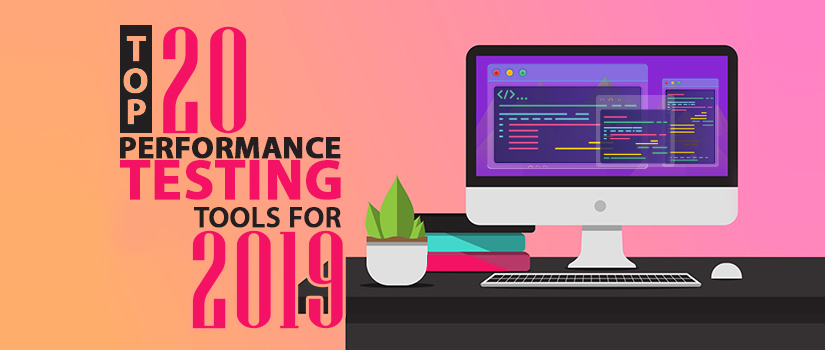Performance Testing Tools are boon when it comes to the automation of performance testing. Performance testing will make sure that your software will eventually become.
- Scalable
- Stable
- High-speed loading
- Improved server response time
- High in UX (User Experience)
However, there is a multitude of performance testing tools available at the moment. To ease the confusion we have compiled a list of top 20 performance testing tools that are put to use by testers and software testing companies at the moment.

What is performance testing?

Performance testing a life-saving process for both mobile-based apps as well as web apps to determine how they will perform in certain adverse conditions, I,e you can detect bottleneck of any system easily and rectify it. in short, response time, speed, load issues, scalability, etc. can be found out
Difference between Performance Testing and Load Testing
| Performance Testing | Load Testing |
| Used to find out the performance of the system, Performance in here means reliability, scalability, etc. | Load testing is meant to analyze system behavior at an unusual load |
| The normal load will also be used | Relies on high load |
| Kind of validation technique | Can serve as an evaluation technique |
| Fatal issues that can affect the software can be detected | After tweaking, will the software hold? Can be found out |

WebLOAD is a load and performance testing tool specifically designed for web applications.
Features
- Rated enterprise-grade, the tool is every enterprise’s first choice to complex testing requirements.
- Flexibility and ease of use are among the two important strengths of the tool.
- Furthermore, WebLOAD also supports over a hundred technologies from web protocols to enterprise applications.
- Helps in correlation, response validation, native Java Scripting, parameterization, messaging, and debugging.
- More than 80 configurable report templates that will help you in root cause analysis
- It can be used to integrate with other APM tools and open-source software.

StresStimulus is a strong performance testing tool because it addresses application scenarios that are difficult to test with other tools.

Features
- StressStimulus records user actions and replays them in order to emulate variable usage patterns. Additionally, it also monitors load impacts and fixes playback errors.
- Easy to access UI
- Supports all app platforms
- Can integrate with web debugging tool Fiddler
- Complete performance analytics with graphical interpretations, test reports, etc.
- Load testing can be automated and recorded
- Recorded test values can be altered using external data
- Scripting is not required but the option is there
- Response time, minimum, maximum, network bandwidth, error rate, requests per second, and average values can be graphed along with VU count.

A Java platform application, Apache JMeter can be integrated with the test plan.Though the tool was initially designed for testing just web applications, its scope has been widened recently. Nevertheless, it works only under UNIX and Window OS.
Features
- Can be used for performance testing of different applications and protocols
- Exceptional IDE that helps in test plan recording
- CLI (command-line mode) that will help in loading test from any JAVA compatible OS
- Data can be extracted through formats like HTML, JSON XML etc.
- Dynamic HTML report
- Completely portable
- Multi-thread feature that allows concurrent sampling
- Offline analysis of test results

LoadUI Pro made it to this list because it is the best tool that could create scriptless and sophisticated load tests in the shortest time.
Features
- Detailed reports can be accessed, and load tests automated on Bamboo, Jenkins, TFS, or any other automation frameworks.
- Moreover, functional tests from SoapUI can be quickly converted into load tests using LoadUI Pro.
- Can be used to perform API load testing
- Provides insight to improve performance
- The monitors server response to various requests
- Existing functional test cases be re-used
- Using remote agents load generators can be created
- Various types of loads can be simulated

Load View is a cloud-based performance testing tools that make use of real browsers to run a performance test on websites as well as web applications.
Features
- The test results are made available as real-time online graphs. Furthermore, tasks for simple calls to download content as well as a complex interaction that stimulates user interaction can be performed using Load View.
- 100% cloud platform. Used GCP and AWS
- Features of the tool make it a perfect fit for DevOps
- Number of load injector servers can be identified
- Load servers located at various geographical zones

The Rational performance tester is the right option for building an efficient error-free cloud computing service.
The tool can be used for both server-based applications and web applications. Developed by IBM, the automated testing tool comes in many versions.
Features
- As simple as it can get
- Can be used to create advanced test scenarios
- Simple test data and sharing
- The analysis is extensive and easy

An innovative performance testing tool, NeoLoad automates test design, maintenance, and analysis for DevOps, as well as agile teams. In order to support performance testing across the life cycle – the tool integrates with continuous delivery pipelines.
Features
- Dedicated support for all the latest web technologies
- Supports script less design and visual programming
- Detects application-specific parameters automatically
- Transaction list that has been pre-filled for easy recording.
- Proxy mode and DNS tunnel mode
- Supports many web security certificates
- Special features that can be used to test audio and video

WAPT, the abbreviated form of Web Application Performance Tool is a tool designed specifically for websites and internet applications.
Features
- Other than measuring the performance of web interfaces, it also enables the user to run performance tests under different load conditions and environments.
- A simple test design approach
- Easy to understand HTTP requests that can be altered
- Emulation of such requests is done by spawning multiple sessions
- Graphical representation of test analysis

This tool is a performance testing version of Loadrunner. It lowers the cost of distributed load testing and reduces the risks of deploying systems that don’t meet performance requirements. With effective tool utilization tracking, HP Performance Tester predicts the system capacity to lower the hardware and software costs.
- Can be integrated into development tools
- Performance bottleneck can be traced out
- Has in-built Cucumber 4 BDD template
- Root cause analysis

This performance testing tool is mainly used in cloud-based services as it aids in website optimization and improving the performance of web applications. It also brings in traffic to the website by stimulating users to determine the amount of stress and load the website can work efficiently at. Furthermore, the system works well on both Windows OS and LINUX.
Features
- Powerful scripting environment that can help you in creating API test scenarios
- Test Scenarios can be created based on virtual users
- Can be integrated into CI-CD pipeline

Rated enterprise-class, Silk Performer is capable of testing multiple applications in different environments that hold thousands of simultaneous users.
Moreover, the tool also supports a wide array of protocols. Lastly, Controllers or Individual protocols require no License, and it is customer friendly to use.
Features
- Existing bump tests can be used to accelerate the test cycle
- A peak load scenario can be created
- End-to-end diagnostics to detect error from the user perspective
- Real-world tests and user pattern can be simulated

We had talked about JMeter earlier, and SmartMeter.io is an alternative to it. This tool enables users to perform test scenario creation with scripts and excels in test reporting. GUI tests can be run with real-time results.

Features
- Embedded browser to create test scenarios within minutes
- 100% Jmeter compatibility
- Advanced reporting
- Can be added easily to CI pipeline
- Can be used to create virtual users from various geographical locations

An easy to use and affordable performance testing tool, LoadComplete creates and executes realistic tests for both web apps and websites. The system requires a 64-bit operating system to work like Windows XP Professional or Windows 7. Furthermore, it also provides detailed reports and metrics which help gain in-depth insights.
Features
- 60% reduction in the test creation time
- The load can be created using 1000s of real browsers
- Real-time VU inspector and debugger
- Zephyr and Jira integration for test management
- Data drive load tests

AppLoader is specifically designed for business applications as it would allow you to test applications by replicating the same user experience from all access points.
Features
- When a user uses the application, the scripts are generated automatically which can be further edited without coding.
- Regular updates and strong support is an additional advantage of the AppLoader.
- An unexpected event can be avoided by Apploaders intelligent engine
- Triggers alarm if the playback exceeds a certain time

Testing Anywhere is an automatic tool that works well in the case of websites, web applications, and other objects. The tool is mainly used by developers to find bottlenecks in web applications. Considered powerful, it takes just 5 steps to create a test. The tool is compatible with all versions of Windows OS.
Features
- One of the best tool when it comes to performance test automation
- Advanced web recorder
- Image recognition

This desktop-based advanced HTTP testing tool records scripts that are easy to use.
Features
- In order to validate the response, the scripts can be modified using the GUI.
- After the execution of the tests, reports are generated for analysis. Loadster system requires a Windows 7/Vista/XP to work on.
- Dynamic datasets can be bind to the scripts
- Validators and captures will make sure that the response is coming back to you

Also known as ManageEngine, it is a widely used automated testing tool.
These Performance Testing Tools perform remote tests on web services from any geographical location.
Alongside, it also offers other testing options such as functional testing, stress testing, load testing, etc.

CloudTest test websites, APIs, mobile apps and more. The cloud platform could be literally used as a virtual testing lab where developers can carry out tests in a cost-effective way. Though the services are not free and the price differs according to the number of load injectors required, the trial version with a power of 100 concurrent users is still available for free.
Features
- Used for stress testing websites and apps
- Rapid test creation without coding
- Gives you insights on what needs to be done to improve the performance of your website or app
- Ability to identify and isolate performance bottlenecks

OpenSTA is the abbreviated form of Open System Testing Architecture. It is a GUI based tool and is believed to be comparatively complex than the other tools present in this list.
Features
- The results and statistics are taken through a number of tests to carry out the test successfully. Nonetheless, the tool is completely free to use.
- Record and replay option
- Results and statistics can be collected during the test run
- Data logged can be monitored live in between the test

Being the first unified test automation platform, this tool erases the redundancies by unifying tests.
21. Load Ninja
Real user-end performance can be simulated across thousands of browsers with ease. Thanks to Load Ninja
Other features of Load Ninja includes,
- Record and instant replay options
- Various metrics to analyze the performance of the software
- Load tests can be automated and integrated into CI/CD pipeline
- Apart from load testing, the tool can be used for soak testing as well
Read Also: Top 10 Automation Testing Tools 2019
Features
- Offers complete integration with Rally, Jenkins, Hudson, Jira, and Bamboo.
- Reduces cost and allows the team to work together and collaborate.
- AI-driven
- Integrates well with CI/CD pipeline
